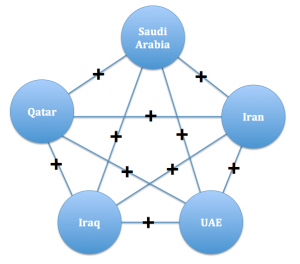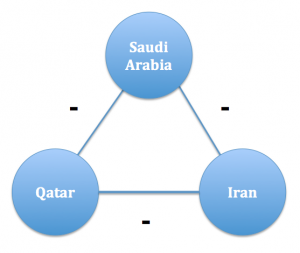Structural Balance Theory and the Qatar Embargo Crisis
Back in June, several Middle Eastern countries, including Saudi Arabia, cut diplomatic ties with Qatar after accusing the country of funding terrorist organizations. They placed a trade embargo against Qatar that decreased total imports into the country by 40% within the first month. After learning about the notion of structural balance and the theories behind it, I decided to revisit the ongoing crisis in the Middle East and look into the interrelations of some of the countries involved.
Saudi Arabia, Qatar, and Iran are all part of the Organization of the Petroleum Exporting Countries, also known as OPEC. OPEC nations are responsible for over 40% of the global oil production and control 73% of total proven oil reserves. They aim to influence oil prices by controlling production output. Although production quotas are not strictly enforced, cooperation among members ultimately benefits everyone in the long term. If cooperation is seen as a positive trait, all members of OPEC can be considered to have positive relationships with each other. However, politics involve much more than oil. OPEC members have their own unique sub-agendas, which have often led to conflicts among members. The most famous example is the invasion of Kuwait by Iraq. Cooperation on issues related to oil production does not necessarily indicate diplomatic alliances. The multifaceted aspect of diplomatic relations (economic, militaristic, nuclear, etc) makes it difficult to assign a definitively positive or negative relationship between countries. The figure below depicts the relationships between a few OPEC member nations when it comes to oil production. It is not an inaccurate representation of actual diplomatic relations.
Nonetheless, the development of diplomatic relationships between Saudi Arabia, Qatar, and Iran during the recent embargo crisis exhibits some of the properties of structural balance theory discussed in class. In an attempt to establish its power in the Gulf region, Qatar has been competing directly against Saudi Arabia. It has also contributed to the instability of the Saudi regime by supporting Islamist organizations. The Saudi-led embargo against Qatar reflects the negative relationship between the two countries. Saudi Arabia also has a negative relationship with Iran due to political and religious reasons. Leading up to the embargo, Qatar had no diplomatic relations with Iran. Qatar severed ties with Iran in January 2016 after two Saudi diplomatic facilities in Iran were attacked. When the embargo was first implemented, Saudi Arabia, Qatar, and Iran all had negative relationships with each other and formed a structurally unbalanced triangle as seen in the figure below.
However, an interesting development took place less than a week after the embargo. Iran announced that it would allow Qatar to use three of its ports to bring supplies into the country. Shortly after that, Qatar restored diplomatic ties with Iran, creating a structurally balanced triangle between Saudi Arabia, Qatar, and Iran.

Although the political environment can be unpredictable, looking at the interrelations of different countries and thinking about the properties of structural balance theory may shed insight into what may happen next. Considering the historically strained relationship between Iran and Saudi Arabia, as well as the joint venture at the South Pars/North Dome gas field between Iran and Qatar, it was no surprise to see Iran and Qatar form diplomatic ties with each other.
Sources:
Saudi Arabia, UAE, Bahrain and Egypt cut ties with Qatar
Qatar restores diplomatic ties with Iran
Qatar Restores Full Relations With Iran, Deepening Gulf Feud


